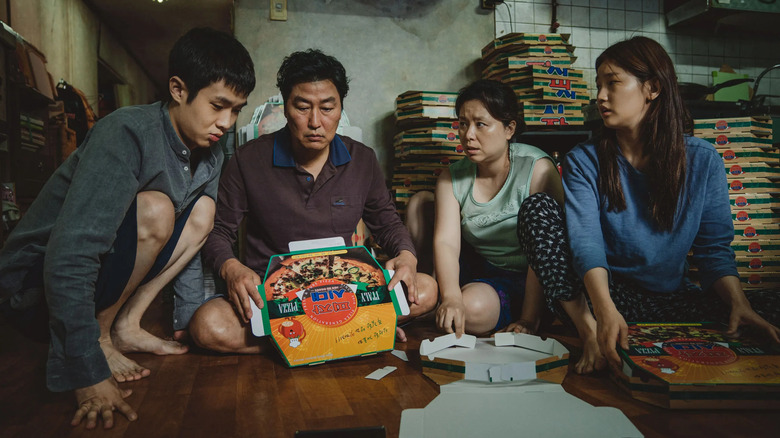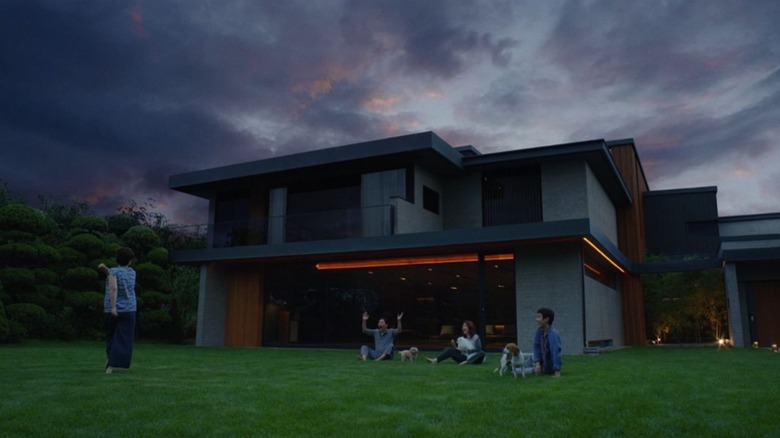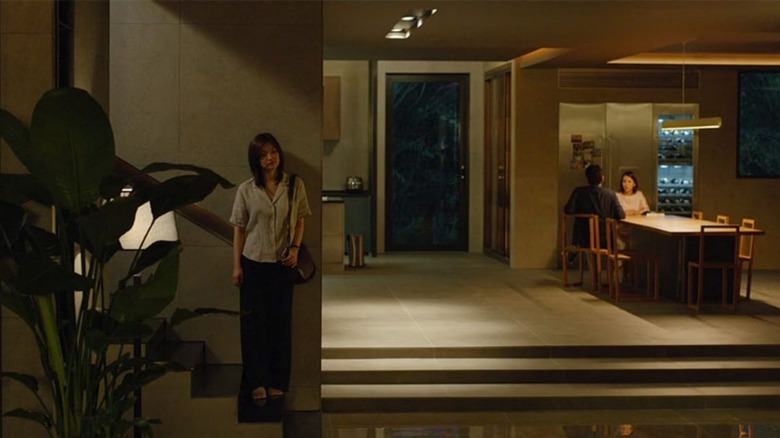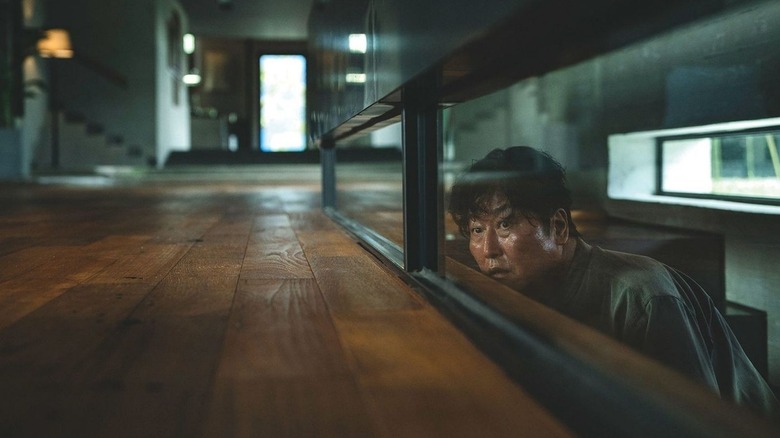Bong Joon-Ho Spared No Expense Putting Together The Parasite House
Filmmaker Bong Joon-ho's Oscar-winning film "Parasite" has been praised for, among many things, weaving social commentary into its plot. Each existing element deliberately serves to further the film's commentary on social class, including the massive glass house where the wealthy Park family lives.
"Parasite" is founded on misunderstandings and teeming with metaphors and symbolism. The use of stairs magnifies the social divide between the Park and Kim family, keeping up with the film's prominent theme of class discrimination and wealth disparity. The film almost entirely hinges on the Park family's massive house — an elaborate construction designed to meet Bong Joon-ho's exact requests. The house first appears as a symbol of wealth, but it is soon unraveled like a puzzle with pieces even its owners know nothing about. The South Korean filmmaker was well aware of just how integral the Park mansion was to the story; it's a plot device on its own. So Bong spared no expense putting it together to represent both wealth, and an inevitable, incoming mystery.
Bong Joon-ho knew exactly what he wanted the Parasite house to look like
It's unbelievable how realistic the house in "Parasite" appears to be, despite being four sets seamlessly put together in post-production. Production designer Lee Ha-jun's process of constructing the array of sets that serve as the film's central location was briefly illustrated by filmmaker Bong Joon-ho in an interview with Vulture Magazine.
The Oscar-winning director explained how important it was to get "the overall structure right for storytelling," that there needed to be moments where characters could eavesdrop on each other or hide from their employers. They needed to equip the home carefully to make these moments possible. And when they managed to get it right, the director's crew worked toward furnishing the set with extraordinarily expensive props that gave Lee "a nervous breakdown every day." Bong even joked about how maybe wealthy audience members would be able to identify pieces of furniture that had been selected for the fictional "Parasite" house:
"The props, furniture, and paintings [in the Park house] were really expensive, so they would always tell the cast and crew, 'Be careful!' But me and the crew members don't know why it's so expensive. Maybe some rich audience members can recognize it. Maybe uptown New Yorkers at the New York Film Festival."
Bong Joon-ho spent a pretty penny on the furnishing
The furniture was customized specifically for the house by South Korean artist Bahk Jong Sun, known as a master of minimalism and restraint. His aesthetic, angular design was deemed ideal for the Park mansion. Bahk's work finds inspiration in traditional Korean furniture that dates back to the 17th and 18th centuries and midcentury Scandinavian modernism, which we see glimpses of in the movie. Production designer Lee Ha Jun https://www.vulture.com/2020/02/how-bong-joon-ho-built-the-houses-in-parasite.html:
"[The furniture] has a warm as well as a cold, metal-like feeling with the straight-cutting edges and clear ratios. We made a large table in the form of stairs, made of four boards of different levels. To make the scene work, the art-design team and the production team constantly lie down on the floor and ran simulations. We needed a structure and a level where Mr. Park couldn't see Ki-taek's family whatsoever, whether they were lying straight or on their sides."
Lee was concerned about how expensive the furnishing was and often asked the crew to be vigilant when moving around the house. For instance: The cherry wood-constructed table cost $19,800, and the dining table where Mrs. Park first meets Kevin is valued at a startling $22,300. Every chair cost the crew $2,100, and there's a brass lamp worth $14,000. Notice the exquisite paintings adorning the walls in the house? There's one displaying a forest that is worth $120,000. Just how wild is that?
Bong's dedication knew no bounds
Bong Joon-ho is a great filmmaker — the award-winning director focused on every little detail, right down to the trash can. No, seriously. "The trash can cost like $2,300! It was German," stated Bong. He picked one that would look great on the big screen, keeping the rest of the house's aesthetic significance in mind. He continued to Vulture:
"Me and my crew members were like, 'What the f***? What kind of idiot would buy a trash can that's going to smell anyway?' When you step on it to open it, it would open really smoothly, and then when you released your foot, it would quietly close like some sort of computer graphic."
Bong demonstrated how the lid of the expensive trash can would close, making a "ssaaak" sound, which Vulture compared to that of a door closing on a "Star Trek ship." Bong confirmed, "So that's why the German one is expensive, I guess."
"Parasite" is a profoundly unsettling family thriller that explores social mobility, class, and hierarchy. The high-concept Park family house is incredibly crucial to the film's narrative — it's no wonder Bong Joon-ho spent a fortune gathering elements that would bring out its best.



